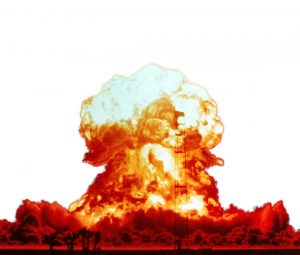The overarching goal of the P5 + 1 agreement with Iran is a good one. But it can only be realized if Iran’s leadership is compelled to acknowledge the right to existence of all other countries, including Israel. The deal, as it stands, has a flaw: It is purely technical. But peace is not a mere technicality. It is a fundamental political decision, and one which Tehran must also respect…

National Nuclear Security Administration Nevada Site Office / Public Domain
The advocates of a policy of peace at any cost are claiming the result of the summit meeting between President Donald Trump and North Korean dictator Kim Jong-un supports their position. They point out that Kim has agreed to halt nuclear weapons production. President Trump is boasting that it was his hardline approach that convinced Kim to cease his nuclear threats and perhaps even agree to dismantle his nuclear weapons program.
Others see the agreement between Trump and Kim as convincing evidence in support of the nuclear deal between Iran and the permanent members of the UN security council plus Germany. Donald Trump, who has just withdrawn from the deal, disagrees. He has called the agreement “the worst deal ever” – and with good reason, for the Iran deal has a fatal flaw. A political deficit. The 2015 agreement is purely technical. The mullah regime, which has been in power since 1979, stepped up its nuclear program in the 1990s. Tehran’s political goals are also dictated by religious and nationalist principles. The post-revolutionary regime regards itself as the Shiite vanguard in the battle for supremacy over the Sunni majority in the Islamic world. Above all, however, Tehran aims to wipe the “Zionist cancer” of Israel off the map. The two strategic goals are linked. By threatening the Jewish state and purporting to spearhead the fight against Israel, Tehran seeks to attain hegemony in the ummah of the Islamic world.
Over the past few decades, it has become clear that Tehran’s activities would eventually result in the development and construction of nuclear weapons. The world powers then embarked on a program of containment. By promising to release up to $100 bn in frozen assets and to loosen and ultimately eliminate sanctions, the P5 + 1 group induced Iran to agree to at least scale back its nuclear weapons program. However, Tehran vehemently rejected the West’s suggestion that it acknowledge Israel’s right to exist and diminish its military activity in the region. Israel and the moderate Arab states, particularly Saudi Arabia and Egypt, appealed to Washington and to European governments to put the brakes on Iran’s political and military activities as part of the deal. In vain.
Tehran insisted on maintaining its political and religious trajectory. And the western states, including Germany – whose Chancellor, Angela Merkel, described Israel’s security as part of the German state’s raison d’être in a 2008 address before the Knesset – acceded to Tehran’s vehement demand.
Overarching goal
The result was the nuclear deal of 2015. Iran reduced the number of centrifuges for enriching uranium and lengthened its break-out time – the time it would take to have enough uranium to manufacture a nuclear bomb – to a year. In return, frozen Iranian assets were released and sanctions were lifted – against the wishes of the affected Arab states and Israel. Iran immediately deployed the funds to intensify its political and military activities in the Arab world. Tehran gained dominant influence in Iraq. In Lebanon, the Hezbollah militia, which receive political and military support from Iran, gained power, as did the Sunni Hamas group in Gaza. In the Syrian civil war, Iran supplied military advisors, mercenaries, and funds in support of dictator Bashar al-Assad. In Yemen, Tehran egged on the Houthi militia in their battle for dominance and encouraged their attacks on Saudi Arabia. These measures are all intended to destabilize the Sunni monarchy. At the same time, Tehran intensified its rocket program for the transport of nuclear weapons.
Iran also stepped up its attacks on the countries it has deemed enemies – Israel and Saudi Arabia. Saudi Crown Prince Mohammed bin Salman, who is prepared to reach a settlement with Israel, is not willing to allow his country to be needled and attacked by Iran. Riyadh and the UAE are defending themselves against Iran’s attacks. Israel is responding to Iran’s attacks from Syrian soil with massive military strikes against Tehran’s outposts in Syria. The goals of the P5 + 1 deal have been stood on their head. Instead of bringing peace to the region, Tehran has been provided with the means to escalate its pursuits against Israel and Sunni countries.
The overarching goal of the nuclear deal is a good one. But it can only be realized if Iran’s leadership is compelled by the P5 + 1 to acknowledge the right to existence of all other countries. Peace is not just a mere technicality. It is a fundamental political decision, and one which Iran must also respect.
